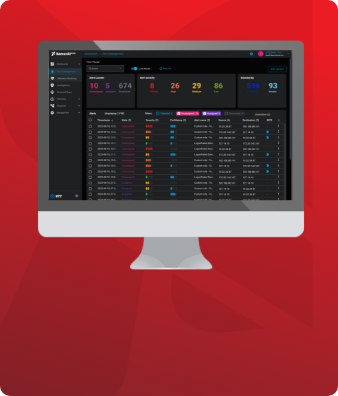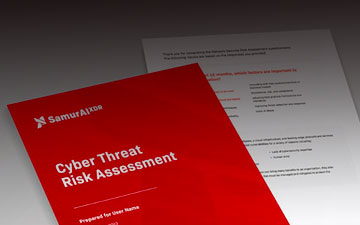Extended detection and response (XDR) solutions represent the evolution and consolidation of network detection and response (NDR) with endpoint detection and response (EDR) tools. XDR focuses on providing comprehensive security across the complete computing environment. An effective XDR solution immediately and automatically responds to cybersecurity incidents.
XDR searches for and identifies potential threats to an organization’s infrastructure. Threats are then assessed and prioritized so they can be evaluated and addressed by the responsible parties. Additionally, XDR provides information that facilitates investigating the threat, including where it originated, if it is spreading, and what damage it may be doing to your computing environment.
XDR technology benefits organizations by enabling more adaptable and complex reactions to cybersecurity incidents and breaches. Its built-in automation results in faster and more accurate responses. XDR’s environment-encompassing approach also provides increased visibility into the complete infrastructure.
Trends and developments in XDR technology promise to increase its usage and improve the security of companies that choose to implement the solution. Let’s look at some specific ways XDR will impact and influence cybersecurity in the future.
Increased adoption of XDR solutions by SMEs
The size of the XDR market is expected to grow from USD 985 million in 2022 to USD 2,358 million by 2027, representing a compound annual growth rate (CAGR) of 19.1%. A large portion of this growth will be due to the adoption of XDR by small and medium-sized enterprises (SMEs).
XDR solutions are appealing to SMEs for several reasons.
- XDR enables SMEs access to a level of cybersecurity capabilities and functionality that have previously been beyond their means to implement. Smaller organizations do not have the financial resources or information technology (IT) expertise necessary to build complex security stacks with initiatives such as security information and event management (SIEM) or security orchestration, automation and response (SOAR).
- The expanding attack surface associated with cloud computing and the mobile workforce has pressured SMEs to improve their cybersecurity posture and infrastructure visibility. XDR provides a consolidated solution that addresses both points.
- The move toward digital transformation has had the effect of storing information assets electronically. This results in organizations of all sizes having the same concerns over data security as large companies and presenting attractive targets for cybercriminals. XDR levels the playing field by offering SMEs a valuable tool for enhancing cybersecurity.
How XDR solutions are expected to evolve
XDR is beyond its emergence stage and is offering more mature solutions. XDR technology is expected to evolve in multiple ways.
Consolidation of security platforms
XDR facilitates the consolidation of other security platforms and can itself be an important component of a comprehensive cybersecurity strategy. Consolidation benefits organizations by:
- Improving the security posture through increased operational efficiency and improved threat detection;
- Reducing complexity and improving security team productivity;
- Addressing the challenges of staffing security teams;
- Providing centralized incident response capabilities;
- Maximizing security spending.
Optimized threat hunting
XDR improves the capabilities of threat-hunting teams in several ways that include:
- Contextually transforming data collected from existing sources for more efficient processing;
- Using machine learning and behavioral models to identify hidden threats;
- Minimizing alert fatigue by selectively choosing alerts for further processing;
- Correlating threats across multiple layers of the network;
- Employing multiple signals to gain a more complete view of the environment.
Implementing additional intelligent automation
Traditional manual methods and limited automation cannot keep pace with the threat detection and response capabilities required to secure a company’s IT infrastructure. Intelligent automation will need to be employed to address the difficulties of efficiently processing the volume of information available over multiple channels and an expanding attack surface. Increased automation improves the speed and accuracy of detection and response activities.
Advanced analytics
AI-powered advanced analytics will be used to perform unassisted threat hunting and autonomously provide recommendations to security teams. Detection will go beyond correlating indicators of compromise (IOCs) with definitions in a threat intelligence database. Analytics will enable dynamic threat detection and the ability to perform deep queries to enable vulnerability management. XDR will also learn to address serverless cloud environments and detect malicious code or functions.
Increased simplicity and usability
A move toward increased simplicity will be a factor in the evolution of XDR solutions. Customers will insist on more out-of-the-box functionality and a minimal learning curve. The goal is to deliver maximum threat detection and response with minimum complexity.
Cybersecurity trends influenced by XDR
Cybersecurity trends will be influenced by the requirements of XDR and its adoption by the security community.
- Vendor consolidation - Along with security platform consolidation, vendor consolidation will occur as companies attempt to streamline vendor management and reduce costs. Vendors offering comprehensive security solutions that incorporate XDR capabilities will have an advantage in the market.
- Cloud-native solutions - Cloud-native solutions will become more dominant since they are architected to address the scalability issues found in cloud environments. Data ingestion can become challenging as an organization grows, and the XDR service they employ needs to be able to keep pace as the environment grows. Customers should also be able to purchase and use only what they need when protecting cloud IaaS and PaaS environments.
- Quality of incident response outcomes - XDR vendors will need to deliver services that successfully detect and respond to threats. The quality of response outcomes will become a differentiating factor that separates XDR services and vendors. The caliber of the artificial intelligence (AI) and machine learning (ML) capabilities that XDR solutions deploy for incident response will be essential to their success.
- Noise reduction - The expanding attack surface and volume of data results in additional strain on security teams. XDR solutions will need to reduce the noise of excessive threat alerts by prioritizing threats and delivering recommendations only at appropriate times. Problems that cannot be addressed by automation need to be quickly brought to the attention of the security team.
How Samurai XDR Improves Your Cybersecurity
Samurai XDR is a cloud-based, SaaS solution that helps your business stay a step ahead of cyberattacks. It’s vendor-agnostic and works within an organization's current ecosystem, so you don’t have to invest in more tooling, or change what you already use. Samurai XDR’s threat intelligence not only provides the “knowledge” needed to detect threats but also to identify where threats originate, what’s motivating them, and how they can be stopped. It’s built with advanced AI and ML technology that provides effective automated response management.
Samurai addresses the emerging trends we’ve identified in a variety of ways including:
- Offering organizations threat detection and response capabilities in a cost-effective SaaS service;
- Optimizing threat hunting with advanced threat intelligence and integration with additional data streams;
- Providing advanced analytics and intelligent automation for excellent response outcomes;
- Reducing complexity with a consolidated alert dashboard.
Sign up for a 30 day free trial and see Samurai XDR in action for yourself.
Featured articles
Identity Management in the Physical and Digital Worlds
7 August 2024 | Webinars
In today's rapidly evolving world, managing identities securely and efficiently is more crucial than ever. Join us for an insightful...
Identity Management in the Physical and Digital Worlds
30 July 2024 | Webinars
In today's rapidly evolving world, managing identities securely and efficiently is more crucial than ever. Join us for an insightful...
XDR for Small and Medium Businesses: Is It Worth It?
24 July 2024 | XDR
Cybersecurity is of paramount importance to virtually all organizations and SMBs have to address several specific challenges. The failure to...





